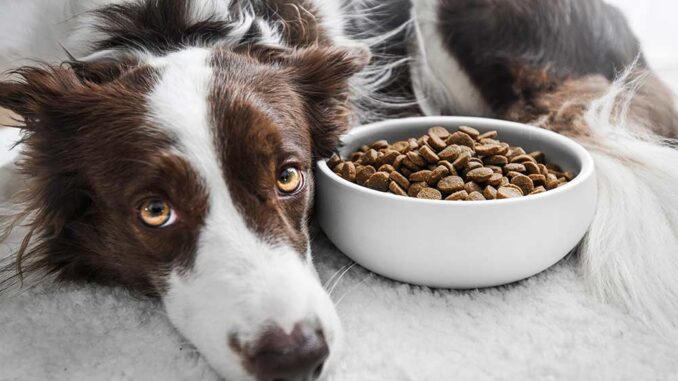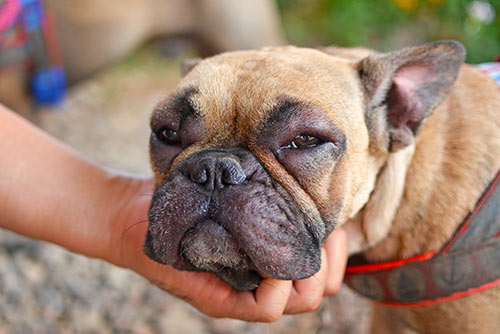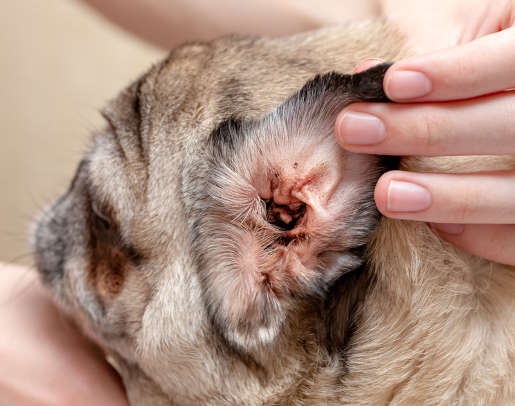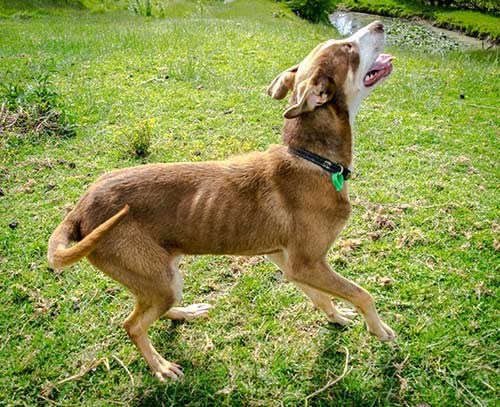
Those with true grain allergies can develop signs including diarrhea, vomiting, bloating, itchy skin and chronic skin infections. Signs would usually occur in the first few years of life and may wax and wane. Pedigree dogs are more prone to grain allergies and most will be ‘atopic’. This means they are prone to allergies in general and will often have environmental allergies and other food allergies, alongside their grain allergy.
Overview of grain allergies in dogs
Grains are found in many dog foods as well as in treats and dental sticks. We also find grains in foods that owners may share with their pets including biscuits, bread and cakes.
Signs may seem to worsen right after a dog eats grain, or may be chronically present. It can be difficult to pinpoint the reaction to grain, as signs such as diarrhea and itchy skin can have lots of other causes.
How prevalent are grain allergies in dogs?
Probably my first comment on grain allergies, as a veterinarian, would be that they are largely over-diagnosed by owners. Less than 1% of dogs have true food allergies and it is more common for a dog to react to beef or chicken than to grain (1).
In those with food allergies, about 13% will seem to react to grain. This can include grains such as wheat, oats or barley.
Take a look at this interesting article to discover more about canine food allergies.
Do grain allergies ever go away?
No, most food allergies will be lifelong. While they can be frustrating to manage, once we know what the dog reacts to, if we keep grain out of their diet, the dog will soon become a lot more comfortable.
What you can do to manage grain allergies to help your dog
If you suspect an allergy or your vet has diagnosed a grain allergy, the treatment is to avoid grains completely. Even the tiniest amount of grains ingested (like your dog nibbling on your bread) can cause signs to flare up for weeks after.
Everyone who feeds the dog needs to be very strict, avoiding grains at all times. For dogs who scavenge food when outside, you may need to use a basket muzzle.
It can take 8 weeks of these changes before improvement is seen, so owners are encouraged to not give up on the elimination diet too quickly.
To improve skin health, owners may consider starting skin supplements as well as probiotics.
Food to avoid
While it can seem daunting initially, once you are used to feeding your dog a grain free diet it will soon become second nature. Be sure to always read the food packaging labels, even on treats or supplements you would not expect to contain grain. Foods to avoid include:
- Any commercial dog food that contains grains. This would include oats, corn, rice, barley and wheat among others.
- Dental sticks or chews that contain grain
- Treats that contain grain
- Supplements or medication that contain grain
- Human foods that contain grain, such as bread, cakes, biscuits and porridge

I would also advise these patients steer clear of any cleaning products or shampoos that contain grain such as oat-based shampoos.
What are the causes of grain allergies in dogs?
For most, allergies are genetic. They may have a parent with an allergy, or perhaps a sibling. Certain breeds are more prone to food allergies and this would include the West Highland White Terrier, Labrador, French Bulldog, Cocker Spaniel and Pug.

There are other theories that specialists are researching as to the cause of canine food allergies, including an imbalance in the gut flora and a faulty skin barrier.
Symptoms of grain allergies in dogs
• Itchy skin. For most dogs, the first sign owners notice is pink and itchy skin. Dogs are usually worst affected on their face, paws, belly and groin.
• Ongoing ear infection and anal gland issues. For many dogs, as well as itchy skin, we will diagnose ear infections and blocked or infected anal glands. This is because there will also be inflammation within the ear canals and anal glands.

• Obsessive licking. As dogs are so itchy, we may find they are constantly licking their paws and rubbing their face.

• Hair loss. The frequent rubbing, scratching and licking will inevitably lead to fur thinning, fur loss and bald patches.
• An upset stomach. Dogs can suffer with ongoing gas, bloating, vomiting and diarrhea.
• Weight loss. Dogs may experience malabsorption of nutrients and a reduced calories intake due to gut inflammation and chronic gastroenteritis. Learn more about weight loss in older dogs.

Diagnosis
Diagnosing a food allergy can be tricky as the symptoms are not specific. For example, an itchy dog with red skin could have a grain allergy but they could also have a chicken allergy, fleas a bacterial skin infection or a hormonal disorder.
Your vet will examine your dog and take a full medical history. They may also advise on some initial testing such as a general blood test, skin swab, skin scrape and stool analysis.
IGE blood tests for food allergies, as well as intra-dermal tests, are available but results are not always accurate. For many owners, these tests are cost prohibitive.
Keeping reaction diaries and food diaries is important. Your vet may suggest a dietary trial, whereby grain is excluded from the diet for eight weeks. If signs resolve, we can reintroduce grain. If signs occur again, a grain allergy has been confirmed.
When to consult the vet
Any unexplained skin inflammation, itching or chronic stomach upset is something we want to bring to the attention of our vet.
These signs impact on a dog’s quality of life and often worsen over time. So, bringing your dog in to see their vet once you notice excessive itching, red skin or ongoing diarrhea is a must.
Treatment options and likely costs
Generally, the treatment is to control signs and to eliminate grain from the diet. For those patients experiencing a skin flare up, treatment may consist of anti-itch medication, antibiotics and/or medicated washes. Depending on the size of the dog, a course of this medicine will cost from $60-200.
Grain free diets are widely available and many cost a similar price to other commercial diets.
Frequently Asked Questions
•Is it possible for dogs to outgrow grain allergies?
In general, no, a food allergy cannot be cured and is something a dog will have for life.
•Are there specific dog breeds more prone to grain allergies?
Absolutely, certain breeds such as the Westie, Cocker Spaniel and Lab are more likely to have food allergies (2).
• Can grain free diets cause other health issues in dogs?
Recent evidence has shown a potential link between grain free foods and heart disease in some individuals. This link has not been proven but is something owners should be aware of before starting their pet on a grain free diet.
•Can I feed my grain-allergic dog a raw food diet?
This could potentially be an option. However, the diet should be balanced and approved by the FDA. Owners should be made aware of the risks to their dog’s health and their own health when their dog is being fed a raw diet.
•How long does it take to see improvement in dogs with grain allergies after changing their diet?
It can take up to eight weeks for us to see the full effects of a diet change. Owners should be aware that signs may not fully go away if dogs have other underlying issues such as a chronic yeast infection or an allergy to something else alongside their grain allergy.
References
1. https://www.ncbi.nlm.nih.gov/pmc/articles/PMC4710035/
2. https://www.msdvetmanual.com/dog-owners/skin-disorders-of-dogs/allergies-in-dogs
Disclaimer: This website's content is not a substitute for veterinary care. Always consult with your veterinarian for healthcare decisions. Read More.


Be the first to comment